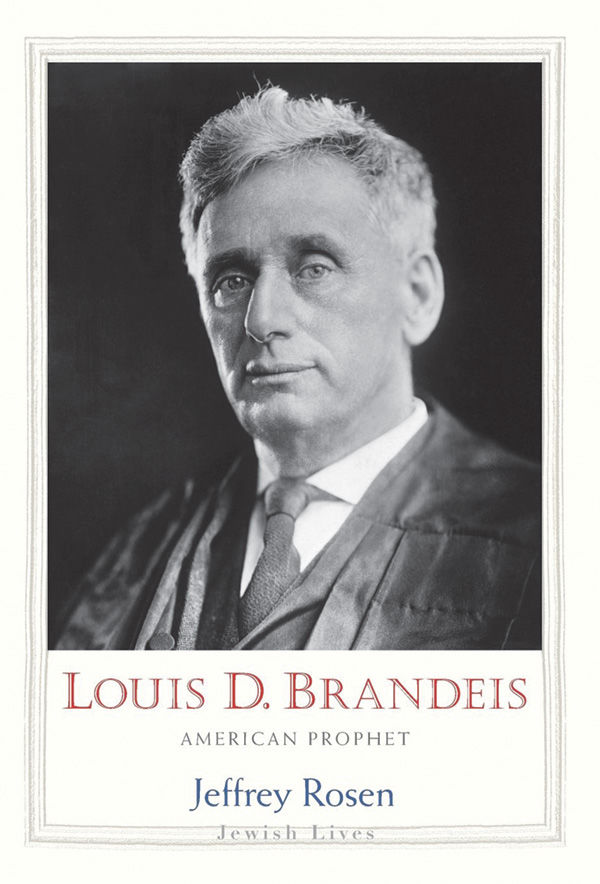New biography commemorates Louis Brandeis, the ‘Jewish Jefferson’
Published October 19, 2016
On June 1, 1916, the U.S. Senate confirmed Louis D. Brandeis to fill a vacancy on the Supreme Court, making him the first Jew to hold such a post.
To commemorate the centennial of this event in June, Yale University Press published “Louis D. Brandeis: American Prophet” by Jeffrey Rosen, a biography of Brandeis that is part of its Jewish Lives series. The series is designed to “illuminate the imprint of Jewish figures upon literature, religion, philosophy, politics, cultural and economic life, and the arts and sciences.”
Rosen is president and CEO of the nonprofit and nonpartisan National Constitution Center, a professor at George Washington University Law School and a contributing editor to The Atlantic. He has also covered the Supreme Court for the New Republic.
ADVERTISEMENT
Rosen makes it clear at the outset of the book that he did not write a comprehensive or traditional biography of Brandeis, but rather a concise, intellectual book for readers who are not legal scholars, and he succeeded.
His biography is tightly written and at times reads like a novel. It is also well researched; Rosen uses existing scholarly literature, as well as Brandeis’ numerous published letters. Rosen has also made extensive use of interviews with three current Jewish Supreme Court justices — Stephen Breyer, Ruth Bader Ginsburg and Elena Kagan — explaining the influences of Brandeis’ judicial opinions and how he and his opinions have become judicial models for them.
It is not merely the sources and writing style that makes this biography so intriguing, but rather Rosen’s constant comparisons of Brandeis and Thomas Jefferson. The two men were so close in their ideology that Rosen refers to Brandeis as “the Jewish Jefferson.” According to Rosen, both men were ardent champions of federalism, a form of government in which the political powers are divided between the state and central governments. Both men favored small government, which they felt upheld state regulations and curbed the excesses of monopoly.
ADVERTISEMENT
The two men also deeply felt that an uneducated citizenry was the greatest threat to constitutional liberties. Both Jefferson and Brandeis insisted that a democracy could not remain free without educated citizens who had the capability of understanding and defending their liberties.
It is in two areas that the similarities between Jefferson and Brandeis become most apparent. One is freedom of speech, found in the First Amendment to the Constitution; the other is the right to privacy, found in the Fourth and Fifth amendments.
With Federalist John Adams in the White House, the fifth Congress passed and the president signed into law the Alien and Sedition Acts, a series of four laws that allowed the president to imprison and deport noncitizens deemed dangerous. These acts also criminalized making false statements critical of the federal government.
In 1801, Jefferson, the prime architect of the Declaration of Independence, succeeded Adams and successfully induced Congress to repeal what he considered the nefarious acts.
When Brandeis first took his seat on the Supreme Court, he voted numerous times to uphold the conviction of socialists found guilty of criticizing the government during World War I. However, in 1927, when Anita Whitney was convicted of advocating sabotage or terrorism as means of accomplishing political change, Brandeis stated that in an open society, she had the right to exercise her freedom of speech. Much of his argument in defending Whitney was based on Jefferson’s rationale that people should be given time and opportunity to engage in “public discussion.” Brandeis’ written opinion quoted Jefferson’s first inaugural address and letters Jefferson wrote to members of Congress.
Like Jefferson, Brandeis believed in the constitutional right to privacy. During Jefferson’s presidency, the right to privacy meant that the government could not open sealed letters without a warrant. When Brandeis sat on the Supreme Court, however, more devious methods had been developed to intrude on a person’s right to privacy, such as wiretapping telephone conversations.
Brandeis was in the minority in a famous case, Olmstead v. United States, in which a bootlegging suspect was arrested and convicted based on information obtained through wiretaps. Although the majority opinion in that case held that the practice did not violate the Fourth Amendment’s search warrant requirements, eventually Brandeis’ minority opinion became the view of the majority of Supreme Court justices.
Brandeis also was a leader outside the court. Although a secular Jew, Brandeis assumed the leadership of the American Zionist movement while in his 50s. Rosen reminds readers that once more, Brandeis, the Jewish Jefferson, saw in Palestine a democratic community with small-scale farming and a democracy resting on the shoulders of yeomen farmers along with small-business men and professionals. Palestine, a new nation, could be fashioned into a democratic society, one that Jefferson would have envisioned and approved of.
Lest readers of this book conclude that Brandeis could do no wrong, Rosen is quite critical of him (as well as of Jefferson) in one important area: They both had a poor record on race.
Brandeis was a Southern Democrat from Kentucky, nominated to the Supreme Court by Woodrow Wilson, a Southern Democrat from Virginia, who in turn who was greatly influenced by Thomas Jefferson, another Virginian. Rosen writes that except for a vote to uphold racially restricted covenants in 1926, neither in his letters nor in the excellent full-length biographies of his life is there any record of his intimate thoughts on the issue of race.
Rosen has added a most interesting and important book to the Yale Jewish Lives Series. His subtitle, “American Prophet,” is very apt. President Franklin D. Roosevelt considered Brandeis a man who resembled an Old Testament prophet and often called him “old Isaiah.”

















